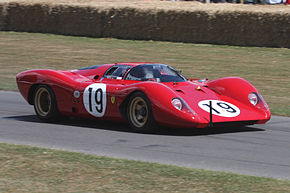Ferrari 312P

The Ferrari 312P was a sports car prototype from Ferrari in 1969 , used in international sports car races.
Development history and technology
After a change in the regulations, Ferrari skipped the entire 1968 season in the brand world championship for sports cars after this short-term change triggered by the seven -liter Ford GT40 had also banned the 4-liter Ferrari 330 from the racetracks.
A new prototype, the 312P, was built in Maranello for the 1969 season. The 312P with its 60 ° V12 3-liter engine was based on the Ferrari 312F1 from Formula 1 . The designation 312 for racing vehicles was introduced by Ferrari with the beginning of the 3-liter formula in Formula 1 in 1966 and used until 1979. The number 3 stood for the displacement of 3 liters, the number 12 for the respective 12-cylinder engines. The P stood for prototype, in contrast to S for the Ferrari 512S sports car, which was built in 25 copies .
As preferred by the rules and also practiced by competitors, the new vehicle was initially designed as an open Spyder ( Barchetta ). Later, a more streamlined, closed Berlinetta version was added, but it was only used on fast tracks, including the 1969 Le Mans 24 Hours .
In 1969 Ferrari only used a 312P in the Manufacturers' World Championship and even this not in all races. Ferrari's commitment remained half-hearted, as the company suffered from a lack of financial strength after several unsuccessful years in motorsport and had given up on offering racing cars suitable for customer teams. This market was taken over by Porsche as well as British and American manufacturers. The last victory at Le Mans was four years ago; the victory of Jochen Rindt and Masten Gregory in 1965 remains the last overall victory in this endurance race. The last world title in Formula 1 was won by John Surtees in 1964 before Niki Lauda became world champion in a Ferrari in 1975.
The 312P was principally a fast car with over 400 HP (294 kW) from the F1 engine, but speed was not enough to withstand the mostly steadfast competition from Porsche (including the Porsche 908/02 as a direct counterpart) and from Ford can. John Wyer's team continued to successfully use the old 4.7-liter Ford GT40 as a sports car, the prototype Ford P68 or P69 Spyder with a Ford Cosworth F1 engine was designed similarly to the 312P, but never finished a race. The Alfa Romeo Tipo 33 now also had a displacement of three liters.
Racing history
At the 12 Hours of Sebring they finished second overall behind a Ford GT40 from John Wyer . After finishing fourth in the 6 Hours of Brands Hatch behind three Porsche 908s , a series of failures followed. In Monza , after works driver Chris Amon's pole position , the car also failed due to an engine failure as it did at the Targa Florio and the 1000 km race at the Nürburgring . The Berlinettas were used in Le Mans . Both cars retired from starting positions five and six in the race again. It wasn't until the 1000 km race in Spa-Francorchamps that there was another sense of achievement through second place overall behind the Porsche 908 of Joseph Siffert and Brian Redman .
Even during the season it became clear that in the future, victories in endurance races would only be possible with a new 5-liter sports car, because Porsche pioneered this direction with the 25 units of the new 917 built .
Enzo Ferrari decided to flee forwards, sold company shares to FIAT and invested part of the proceeds in the construction of also 25 512S , as required by the sports car regulations. The 312P were sold to Luigi Chinetti and his North American Racing Team , who only used the cars sporadically. From 1971 the Ferrari 312PB , now with a 180 ° V12 flat engine, was tested for the 1972 season, from which the five-liter was banned.
Technical specifications
| Ferrari 312 P (1969) | Barchetta | Berlinetta |
|---|---|---|
| Engine: | Twelve-cylinder V-engine (60 °) | |
| Displacement : | 2989 cc | |
| Bore × stroke: | 77 x 53.5 mm | |
| Valve control: | 2 overhead camshafts per cylinder bank, 4 valves per cylinder |
|
| Compression: | 11: 1 | |
| Power: | 309 kW (420 hp) at 9800 rpm | 316 kW (430 hp) at 9800 rpm |
| Transmission: | 5-speed (fully synchronized) | |
| Brakes: | ventilated disc brakes without braking aid | |
| Body: | Tubular frame and supporting sheets | |
| Wheelbase : | 2367 mm | |
| Length × width × height: | 4318 × 2007 × 889 mm | 4230 × 1980 × 950 mm |
| Dry weight : | approx. 680 kg | |
| Top speed: | approx. 310-320 km / h | |

